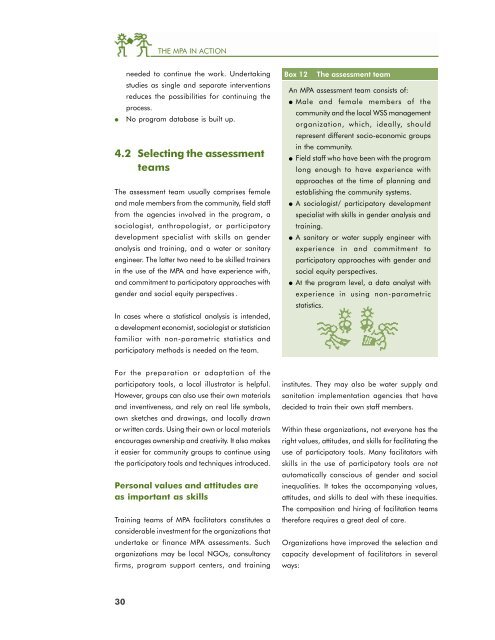Sustainability Planning and Monitoring
Sustainability Planning and Monitoring
Sustainability Planning and Monitoring
- No tags were found...
You also want an ePaper? Increase the reach of your titles
YUMPU automatically turns print PDFs into web optimized ePapers that Google loves.
THE MPA IN ACTION●needed to continue the work. Undertakingstudies as single <strong>and</strong> separate interventionsreduces the possibilities for continuing theprocess.No program database is built up.4.2 Selecting the assessmentteamsThe assessment team usually comprises female<strong>and</strong> male members from the community, field stafffrom the agencies involved in the program, asociologist, anthropologist, or participatorydevelopment specialist with skills on genderanalysis <strong>and</strong> training, <strong>and</strong> a water or sanitaryengineer. The latter two need to be skilled trainersin the use of the MPA <strong>and</strong> have experience with,<strong>and</strong> commitment to participatory approaches withgender <strong>and</strong> social equity perspectives .In cases where a statistical analysis is intended,a development economist, sociologist or statisticianfamiliar with non-parametric statistics <strong>and</strong>participatory methods is needed on the team.Box 12 The assessment teamAn MPA assessment team consists of:● Male <strong>and</strong> female members of thecommunity <strong>and</strong> the local WSS managementorganization, which, ideally, shouldrepresent different socio-economic groupsin the community.● Field staff who have been with the programlong enough to have experience withapproaches at the time of planning <strong>and</strong>establishing the community systems.● A sociologist/ participatory developmentspecialist with skills in gender analysis <strong>and</strong>training.● A sanitary or water supply engineer withexperience in <strong>and</strong> commitment toparticipatory approaches with gender <strong>and</strong>social equity perspectives.● At the program level, a data analyst withexperience in using non-parametricstatistics.For the preparation or adaptation of theparticipatory tools, a local illustrator is helpful.However, groups can also use their own materials<strong>and</strong> inventiveness, <strong>and</strong> rely on real life symbols,own sketches <strong>and</strong> drawings, <strong>and</strong> locally drawnor written cards. Using their own or local materialsencourages ownership <strong>and</strong> creativity. It also makesit easier for community groups to continue usingthe participatory tools <strong>and</strong> techniques introduced.Personal values <strong>and</strong> attitudes areas important as skillsTraining teams of MPA facilitators constitutes aconsiderable investment for the organizations thatundertake or finance MPA assessments. Suchorganizations may be local NGOs, consultancyfirms, program support centers, <strong>and</strong> traininginstitutes. They may also be water supply <strong>and</strong>sanitation implementation agencies that havedecided to train their own staff members.Within these organizations, not everyone has theright values, attitudes, <strong>and</strong> skills for facilitating theuse of participatory tools. Many facilitators withskills in the use of participatory tools are notautomatically conscious of gender <strong>and</strong> socialinequalities. It takes the accompanying values,attitudes, <strong>and</strong> skills to deal with these inequities.The composition <strong>and</strong> hiring of facilitation teamstherefore requires a great deal of care.Organizations have improved the selection <strong>and</strong>capacity development of facilitators in severalways:30
















